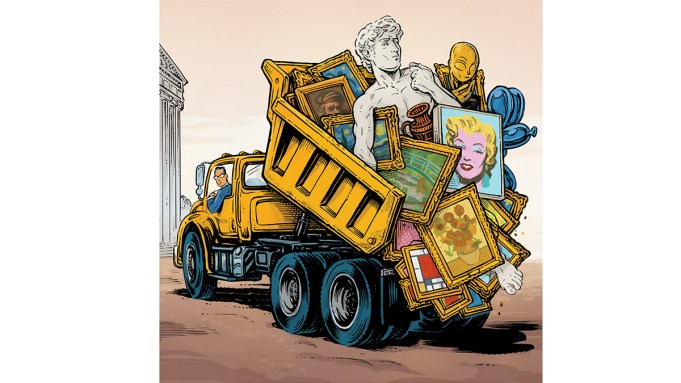
As usual, the most recent Art Basel Miami Beach, in December, was a glittering, celebratory spectacle of wealth and creativity. Champagne flowed, well-heeled crowds mingled, and seven-figure sales made headlines. It was almost enough to belie a simple fact: The art market is already in a recession; it just doesn’t realize it yet—or won’t admit it.
As someone who has spent years immersed in the art world—as a collector, a teacher at Yale University, and an author—I’ve seen the data firsthand. In a 2018 Science paper I coauthored, which examined information on 500,000 artists across millions of transactions, my fellow researchers and I uncovered a striking truth: Financial success stories in the art world are reserved for an extremely small group. In fact, just 20 artists—names such as Jeff Koons, Andy Warhol, and Damien Hirst—dominate more than half of the contemporary-art market’s auction value. (The art world is notoriously opaque, with private deals nearly impossible to track, so for researchers like me, auction results offer the clearest window into the upper echelons of the market.) For the remaining 99.9 percent of artworks, monetary returns are the exception rather than the rule. Consider this: Of the roughly 80,000 enthusiasts who visit Art Basel Miami Beach annually, less than 3 percent actually makes a purchase. For all its glamour, the art world is a precarious ecosystem.
The market has long relied on a shrinking pool of buyers to drive its top end, and these challenges are about to be compounded by an unprecedented generational-wealth transfer. Over the next 25 years, an estimated $73 trillion will pass from baby boomers to Gen X, millennials, and Gen Z. Some portion of that will be tied up in significant art collections, yet heirs often lack the emotional or financial commitment to these works, with roughly 50 percent of inherited collections being sold.
This glut of art entering the market, combined with evolving tastes, spells further trouble for second-tier works. (While Magritte’s L’Empire des lumières recently fetched nearly $121.2 million, for example, other surrealist pieces struggle to sell for less than a hundredth of that price.) It’s a pattern we’ve seen before: In the 1930s, 18th-century French furniture was prized above all else, while a Picasso still life went unsold at auction; today, the reverse is true. The same fate is likely to await a number of artists from boomer collections as the market is flooded with works that no longer align with contemporary tastes, deepening the recession while simultaneously neglecting the core issue of a declining pool of collectors.
And it’s not just the number of collectors that needs addressing, but also how and why they collect. Even as the big names dominate art-fair highlights around the globe, most mid-career and emerging artists fail to generate interest. But these are the artists who rely most heavily on the support of collectors willing to look beyond financial returns. Without a commitment to this level of the market, the network begins to falter.
So, why buy art at all? Because art is not—and should not be—simply an investment. Art offers something far more profound: the chance to support creativity, build cultural legacies, and engage with a community of like-minded patrons. I call this responsible buying, and it reframes the transaction as a philanthropic act. When I purchase a piece, I’m not thinking about resale value. Rather, I’m supporting the artist, enabling her to continue creating. This, in turn, sustains the galleries and artistic communities that form the lifeblood of culture. Collecting art, for me, is a way of doing good that comes with a tangible reward: an object I love, a story to tell, and a connection to a larger narrative.
Some of the most inspiring collectors today share this ethos. Swizz Beatz and Alicia Keys, for example, focus on supporting contemporary Black artists, building not just a collection but also a platform for underrepresented voices. Ronald Lauder’s deep dive into German and Austrian art preserves cultural heritage while fostering scholarship via the Neue Galerie, while Agnes Gund’s advocacy for criminal-justice reform led her to sell a Roy Lichtenstein painting in order to establish the Art for Justice Fund. These collectors don’t just acquire objects, they shape narratives—repositioning art in a way that transcends its role as a commodity to become a force for societal change.
For those with the means to pursue this mission seriously, consider ways to deepen your impact. Commission works directly from artists, fund residencies, or support museum acquisitions. Engage with younger galleries that champion emerging voices. By fostering these connections, you not only acquire art, but also help ensure its continued relevance and vibrancy in a rapidly changing world. Most importantly, buy with passion and conviction, knowing that your purchase has the power to sustain not just an artist, but also an entire community.
My own collection began modestly but has grown to over 80 pieces, each a reflection of this philosophy. I vividly remember the first work I hung on my wall—the joy it brought and the conversations it sparked. That feeling is priceless. It’s why I wrote my most recent book, How to Collect Art, in order to inspire others to experience the same.
Collecting, at its core, is about connection—to the art, to the artist, and to the broader cultural narrative. Whether it’s a Picasso or a print from a young emerging talent, every acquisition tells a story. It’s a dialogue between past and present, between collector and creator. And as collectors, we have a responsibility to ensure that dialogue continues. Not because it’s a sound financial investment, but because it’s an investment in humanity. That’s the true value of art, and it’s worth every penny.
Magnus Resch is an art-market expert who teaches art management at Yale University. His most recent book, How to Collect Art, was published by Phaidon in 2024.
This post was originally published on this site be sure to check out more of their content





